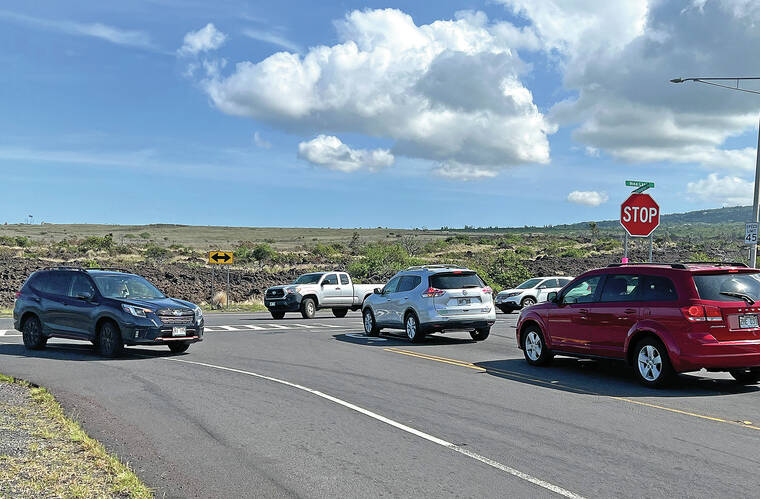Hawaii County’s fuel tax revenues have been coming in higher than expected, and in some cases, faster than the county can spend them.
Even as the County Council is set to vote Wednesday on Resolution 363 giving drivers a break by knocking 10 cents a gallon off the current rate, a council committee Tuesday will vote on a bill to reappropriate $2.5 million left unspent between 2016 and 2020. The Finance Committee is also set to appropriate an additional $700,000 that came in over what was budgeted for the past two budget years that end June 30.
Puna Councilman Matt Kaneali‘i-Kleinfelder sees the numbers as showing even more reason to provide taxpayer relief. He said he hopes the public will testify at the 9 a.m. Wednesday meeting.
“Given this lapsed funding and a nearly $20 million Highway Fund balance, clearly the residents of Hawaii County are being overtaxed,” Kaneali‘i-Kleinfelder said. “At this time, these excess funds would be far more effective in the peoples pockets where they can stimulate all sectors of our economy.”
Fellow council members seem to have taken a dim view of the proposal, with the measure coming out of committee on a 3-5 vote, a negative recommendation.
Most of the half-dozen testifiers who addressed the issue at a public hearing, however, favored the tax cut, saying the high costs are making it difficult for them to make a living. Those opposed pointed out the rough condition of many island roadways, saying the county needs the money to fix them.
The County Council in 2017 raised the county fuel tax from 8.8 cents per gallon to 15 cents, with an additional 4-cent increase in 2018 and another 4-cent hike in July 1, 2019, bringing the total to 23 cents per gallon. The local tax is on top of 16 cents per gallon state tax and 18 cents a gallon federal tax.
The average price at the pump Friday for regular gas on Hawaii Island was $5.437 a gallon, according to the American Automobile Association.
“I work closely with our Highway Department and they work hard to care for our roads,” Kaneali‘i-Kleinfelder added. “Given the data available at this time, it is clear that the county, despite having excess funds, has limited ability to accomplish infrastructure improvements.”
But Public Works Director Ikaika Rodenhurst thinks his department could put the money to good use.
“I believe we can spend the lapsed fuel tax money. We are working with our Highways Maintenance division and Engineering divisions to address the road and bridge maintenance needs of the county,” Rodenhurst said. “We are increasing the amount of road maintenance paving on our schedules and completing the designs of projects eligible for federal funding sources.”
Finance Director Deanna Sako said the money that lapsed was collected prior to the pandemic. Most of the money is for paving projects, she said.
“We were not able to pave last fiscal year so the funds will be reappropriated so that they can continue to do paving around the island,” Sako said.
Bill 161 on the Finance Committee agenda reappropriates the lapsed $2.5 million for specific projects. In addition to the $1.8 million for road repairs, engineering for specific roadway projects will account for $451,774 and bridge inspection, repair and replacement will take another $332,289.
The repair money is allocated to districts based on their percentage of local roads. There were 248 miles of roads on the island classified as in “poor condition” as of 2020, the most current year available from Public Works.
Of those, 68.67 miles were in District 1, 26.81 in District 2, 38.76 in District 3, 12.04 in District 4, 8.24 in District 5, 28.8 in District 6, 15.14 in District 7, 10.87 in district 8 and 29.38 in District 9.
Specific road projects on the list for improvements are Ane Keohokalole Highway Phase III, Kilauea Avenue shoulder improvements, Kinoole Avenue shoulder improvements, Manono Street shoulder improvements, Old Mamalahoa Highway rehabilitation, Oneo Lane and Waianuenue Avenue Safety Improvements.
The 2017 council measure establishing the fuel tax made the increase contingent on “the timely submission of a comprehensive plan by the Department of Public Works in collaboration with the Office of the Mayor providing the following minimum information: amount to be generated by increases; information on how money will be distributed to all districts; transportation projects to be funded in each district; and time-lines for projects utilizing fuel tax revenues.”
Email Nancy Cook Lauer at ncook-lauer@westhawaiitoday.com.




